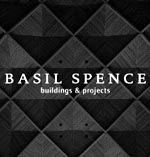Book review: Basil Spence: Buildings and Projects
The work of leading post-war architect Basil Spence is the subject of this fascinating monograph


To order any of the books reviewed or any other book in print, at
discount prices* and with free p&p to UK addresses, telephone the Country Life Bookshop on Bookshop 0843 060 0023. Or send a cheque/postal order to the Country Life Bookshop, PO Box 60, Helston TR13 0TP * See individual reviews for CL Bookshop price.
History Basil Spence: Buildings and Projects Edited by Louise Campbell, Miles Glendinning and Jane Thomas (RIBA Publishing, £45)
In the Britain of post-Second World War reconstruction and the Welfare State, no single architect loomed larger in public consciousness than Sir Basil Spence (1907-76). As Coventry Cathedral, the most popular building of its era, celebrates the 50th anniversary of its opening this year, his name is topical once again-an architect supremely able to make Modernism into something romantic and theatri-cal.
This book is the culmination of a long and thorough programme of research based on Spence's archive, held at the Royal Commission on the Ancient and Historic Monuments of Scotland, and interviews with his colleagues. It is a large and ambitious book, with contributions from David Walker, Clive Fenton, Robin Skinner and Brian Edwards, but is clearly organised with topic-based essays and a well-illustrated list of works. It keeps the needs of a general reader in mind-and gives excellent value for money.
Born in India of Scottish parents, Spence studied architecture in Edinburgh as Modernism was beginning to challenge the acceptance of historic styles for new building. In the 1930s, he swung between flat roofs and concrete for some jobs and steep slate roofs and harled rubble work for others. His experience working in London with Sir Edwin Lutyens on the completion of New Delhi gave him a taste for planning on a grand scale, which he was able to exercise at the Uni-versity of Sussex. After the Second World War, he abandoned historic styles, but retained an almost post-modern flexibility of approach and response to context.
The contributions of partners and younger colleagues in the three offices that Spence ran simultaneously in London and Edinburgh are explained in the book; several of them went on to distinguished careers of their own. Spence was especially skilled in dealing with patrons and steering accidental events to his advantage.
Sign up for the Country Life Newsletter
Exquisite houses, the beauty of Nature, and how to get the most from your life, straight to your inbox.
At Knightsbridge Barracks, a young minister, James Rams-den, who replaced John Profumo, was almost persuaded that the Victorian building did not need replacing, until the daughter of one of the ‘other ranks' popped up unscheduled and showed him the slum conditions in which soldiers had to live with their families. It is hard not to warm to an architect who, when asked by The Queen during a visit to the finished barracks what he was going to do next, replied ‘Duck and run for cover, Ma'am', at which she doubled up with laughter.
Spence resembles the ‘star architects' of the past 35 years more than the self-effacing ser-vants of the State who set the puritanical tone for architecture in the 1950s and 1960s. Few would criticise him for trying to cheer up the world of building, but even with such talent and such opportunities, his best-known work can come across as if scored for a brass band when, as his American contemporary Louis Kahn shows us, it could have had the subtlety and emotional depth of a full orchestra.
to Country Life and save £40%
Country Life is unlike any other magazine: the only glossy weekly on the newsstand and the only magazine that has been guest-edited by HRH The King not once, but twice. It is a celebration of modern rural life and all its diverse joys and pleasures — that was first published in Queen Victoria's Diamond Jubilee year. Our eclectic mixture of witty and informative content — from the most up-to-date property news and commentary and a coveted glimpse inside some of the UK's best houses and gardens, to gardening, the arts and interior design, written by experts in their field — still cannot be found in print or online, anywhere else.
-
 About time: The fastest and slowest moving housing markets revealed
About time: The fastest and slowest moving housing markets revealedNew research by Zoopla has shown where it's easy to sell and where it will take quite a while to find a buyer.
By Annabel Dixon
-
 Betty is the first dog to scale all of Scotland’s hundreds of mountains and hills
Betty is the first dog to scale all of Scotland’s hundreds of mountains and hillsFewer than 100 people have ever completed Betty's ‘full house’ of Scottish summits — and she was fuelled by more than 800 hard boiled eggs.
By Annunciata Elwes